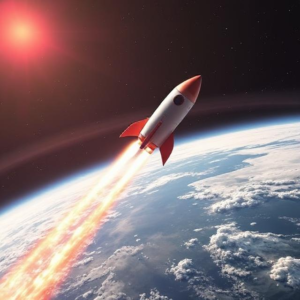What is Escape Velocity?
Escape velocity is the minimum speed an object must have to escape the gravitational pull of a planet, moon, or any other celestial body without any additional propulsion (like rockets). This velocity allows the object to break free from the gravitational attraction and move away indefinitely, without falling back.

In simpler terms, escape velocity is the speed needed to “escape” the gravitational grip of a body, such as Earth.
Why is Escape Velocity Important?
Escape velocity is important because it helps determine how much energy is needed to send spacecraft or satellites into space. It tells us how fast a rocket or any object needs to travel to break free from the Earth’s gravity, or any other celestial body’s gravity, without falling back down.
Formula for Escape Velocity
The formula for escape velocity (v) is derived from the balance between gravitational potential energy and kinetic energy. The formula is:
Where:
- v = escape velocity (in meters per second, m/s)
- G = gravitational constant =
- M = mass of the celestial body (like Earth, in kilograms)
- r = distance from the center of the celestial body to the object (in meters)
How Does the Formula Work?
- Gravitational Pull (G): The escape velocity depends on the mass of the celestial body and the distance from its center. The larger the mass of the celestial body, the greater the escape velocity.
- Distance (r): The escape velocity also depends on how far the object is from the center of the celestial body. The farther you are from the center, the lower the escape velocity. For example, if you’re on the Earth’s surface,
is the radius of the Earth.
- Why the Square Root? The square root in the formula comes from the relationship between kinetic energy (energy of motion) and gravitational potential energy (energy stored in an object due to its position relative to a gravitational source). To escape the gravitational pull, the object’s kinetic energy must equal the gravitational potential energy.
Escape Velocity for Earth
Let’s calculate the escape velocity from Earth:
- G =
- M (mass of Earth) =
- r (radius of Earth) = 6,371,000 meters (or 6.371 × 10⁶ meters)
Using the formula:
So, the escape velocity from Earth is approximately 11.2 kilometers per second (km/s). This means an object must travel at a speed of 11.2 km/s (or about 25,000 mph) to escape Earth’s gravity.
Escape Velocity for Other Celestial Bodies
Escape velocity varies depending on the mass and size of the body being escaped from:
- The Moon: The escape velocity on the Moon is much lower than on Earth because the Moon has less mass and a smaller radius. The escape velocity on the Moon is about 2.4 km/s.
- The Sun: The escape velocity at the surface of the Sun is much higher due to its massive size. It’s about 617.7 km/s (over 50 times faster than Earth’s escape velocity).
Important Points to Remember:
- Escape velocity does not depend on the mass of the object trying to escape, but only on the mass of the celestial body and the distance from its center.
- Escape velocity is the same regardless of the object’s mass or shape. Whether you launch a spacecraft, a rock, or even a person, the escape velocity required is the same.
- Escape velocity is needed to break free from gravity—it’s a one-time requirement to leave the gravitational influence. Once the object has reached this speed, no further propulsion is needed to continue moving away (assuming no other forces, like air resistance, are acting).
Example: Escape Velocity on Earth
- If you were standing on Earth’s surface and wanted to escape the gravitational pull, you would need to achieve a speed of about 11.2 km/s (or around 25,000 mph). That’s roughly 33 times the speed of sound!
Conclusion
Escape velocity is a crucial concept in physics, especially in space exploration. It tells us the minimum speed needed to overcome a planet’s gravity and travel into space. The escape velocity is determined by the mass of the planet and the distance from its center, and for Earth, it’s about 11.2 km/s. This is essential for launching satellites, spacecraft, or any mission aiming to leave Earth’s gravitational field.
Tags: break free, celestial body, distance from center (r), Earth escape velocity, energy balance, escape gravity, Escape Velocity, Formula, gravitational attraction, gravitational constant (G), Gravitational Force, gravitational potential energy, Gravitational pull, kinetic energy, kinetic energy equals potential energy, mass of celestial body (M), mass of Earth, minimum speed, Moon, Moon escape velocity, no additional propulsion, one-time speed requirement, overcoming gravity, physics concept, planet, radius of Earth, rockets, satellite launch, satellite mission., Space exploration, spacecraft launch, speed needed to escape, Sun escape velocity, Velocity calculation, velocity examples, velocity formula square root, velocity in kilometers per second, velocity in meters per second, velocity independent of object mass, velocity independent of object shape


